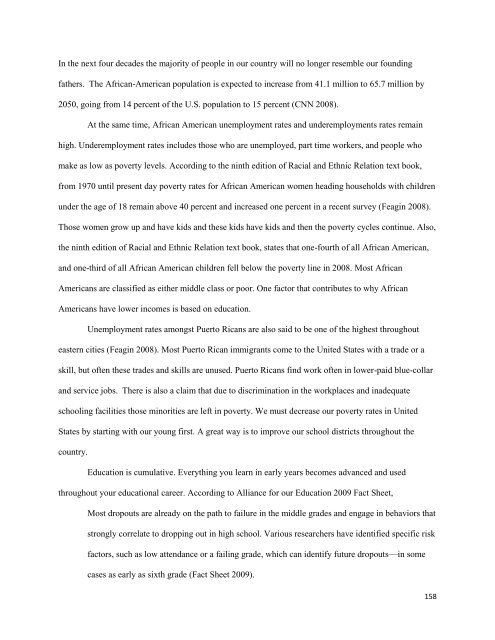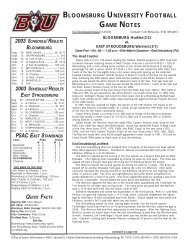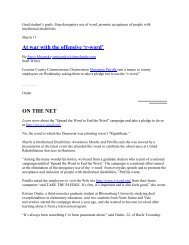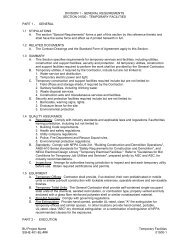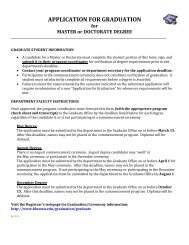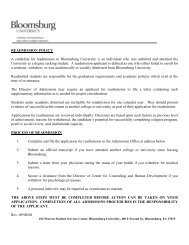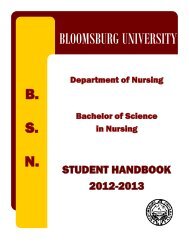Human Rights at Home and Abroad: Past, Present, and Future
Human Rights at Home and Abroad: Past, Present, and Future
Human Rights at Home and Abroad: Past, Present, and Future
Create successful ePaper yourself
Turn your PDF publications into a flip-book with our unique Google optimized e-Paper software.
In the next four decades the majority of people in our country will no longer resemble our founding<br />
f<strong>at</strong>hers. The African-American popul<strong>at</strong>ion is expected to increase from 41.1 million to 65.7 million by<br />
2050, going from 14 percent of the U.S. popul<strong>at</strong>ion to 15 percent (CNN 2008).<br />
At the same time, African American unemployment r<strong>at</strong>es <strong>and</strong> underemployments r<strong>at</strong>es remain<br />
high. Underemployment r<strong>at</strong>es includes those who are unemployed, part time workers, <strong>and</strong> people who<br />
make as low as poverty levels. According to the ninth edition of Racial <strong>and</strong> Ethnic Rel<strong>at</strong>ion text book,<br />
from 1970 until present day poverty r<strong>at</strong>es for African American women heading households with children<br />
under the age of 18 remain above 40 percent <strong>and</strong> increased one percent in a recent survey (Feagin 2008).<br />
Those women grow up <strong>and</strong> have kids <strong>and</strong> these kids have kids <strong>and</strong> then the poverty cycles continue. Also,<br />
the ninth edition of Racial <strong>and</strong> Ethnic Rel<strong>at</strong>ion text book, st<strong>at</strong>es th<strong>at</strong> one-fourth of all African American,<br />
<strong>and</strong> one-third of all African American children fell below the poverty line in 2008. Most African<br />
Americans are classified as either middle class or poor. One factor th<strong>at</strong> contributes to why African<br />
Americans have lower incomes is based on educ<strong>at</strong>ion.<br />
Unemployment r<strong>at</strong>es amongst Puerto Ricans are also said to be one of the highest throughout<br />
eastern cities (Feagin 2008). Most Puerto Rican immigrants come to the United St<strong>at</strong>es with a trade or a<br />
skill, but often these trades <strong>and</strong> skills are unused. Puerto Ricans find work often in lower-paid blue-collar<br />
<strong>and</strong> service jobs. There is also a claim th<strong>at</strong> due to discrimin<strong>at</strong>ion in the workplaces <strong>and</strong> inadequ<strong>at</strong>e<br />
schooling facilities those minorities are left in poverty. We must decrease our poverty r<strong>at</strong>es in United<br />
St<strong>at</strong>es by starting with our young first. A gre<strong>at</strong> way is to improve our school districts throughout the<br />
country.<br />
Educ<strong>at</strong>ion is cumul<strong>at</strong>ive. Everything you learn in early years becomes advanced <strong>and</strong> used<br />
throughout your educ<strong>at</strong>ional career. According to Alliance for our Educ<strong>at</strong>ion 2009 Fact Sheet,<br />
Most dropouts are already on the p<strong>at</strong>h to failure in the middle grades <strong>and</strong> engage in behaviors th<strong>at</strong><br />
strongly correl<strong>at</strong>e to dropping out in high school. Various researchers have identified specific risk<br />
factors, such as low <strong>at</strong>tendance or a failing grade, which can identify future dropouts—in some<br />
cases as early as sixth grade (Fact Sheet 2009).<br />
158


